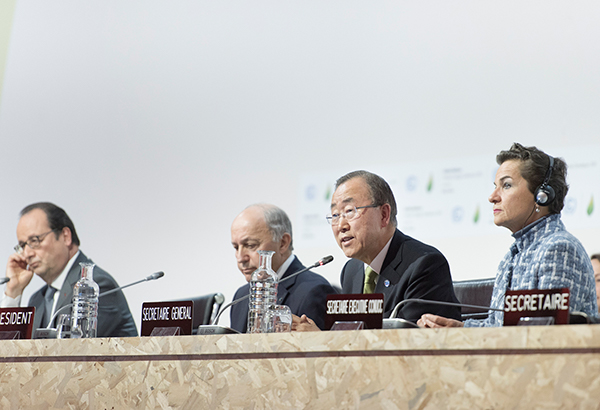Theme
The Paris Agreement is a turning point in the multilateral fight against climate change. Implementation will, however, be key in determining the extent of our collective will to limit dangerous interference with the climate system.
Summary
Many key elements that led to the Copenhagen Accord have evolved in the past six years. Increased scientific evidence, updated economic analysis on the consequences of climate change, technological advances and developments in the energy sector, an increase in the frequency and intensity of extreme weather events and transformations in climate governance have created a narrow window of opportunity through which the Paris Agreement emerged. Some of these key changes as well as the results of COP21 are critically analysed. The analysis concludes that the diplomatic success that culminated in the adoption of the Paris Agreement provides the world with a new global climate governance framework that contains valuable elements in the fight against climate change. However, current mitigation commitments will overshoot the 2°C limit by around one degree. Therefore more needs to be done and work has to start in earnest now if we are to avoid the worst consequences of a changing climate. The task at hand is herculean as solving the climate problem requires profoundly transforming productive systems and consumption patterns.
Analysis
From Copenhagen to Paris
The road from Copenhagen to Paris has been paved by developments in science, economics, energy and climate governance. These are analysed in the subsections below before engaging in a description and preliminary assessment of the key outcomes of the Paris Agreement.
Science, economics and energy
The science is more robust in 2015 than it was in 2009. In fact, the publication of the Fifth Assessment Report (AR5) by the Intergovernmental Panel on Climate Change (IPCC)1 in 2013-14 asserted that climate change is unequivocal, it is already impacting socioeconomic and natural systems alike, and human influence on this process is clear.
There is an overwhelming agreement among scientists (97% agree)2 that climate change is happening and that its anthropogenic component is significant. Additionally, climate-change economists agree that climate models underestimate the consequences of climate change. They also agree that action in earnest is called for as climate change is already affecting our economies, or will do so in the medium and long terms.3 In fact, analysis by Dell et al. (2011)4 on less developed countries, as well as Burke et al. (2015),5 confirm the relationship between economic growth and temperature increases. The latter conclude that economic productivity reaches its peak at an average temperature of 13°C with sharp declines in productivity at higher average temperatures. Burke et al. (2015) conclude that by the end of the century global GDP per capita could be 23% lower in high greenhouse gas (GHG) emission scenarios compared to scenarios where there is no climate change; a powerful reason to limit our emissions. Figure 1 below depicts the economic impacts of climate change by country.
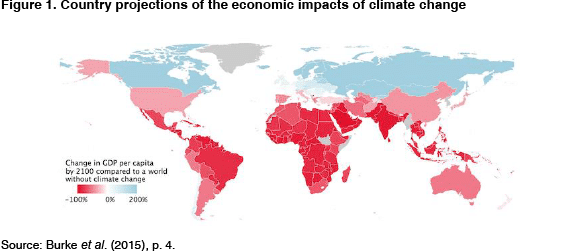
The World Economic Forum (2015)6 claimed that extreme weather events, water and food crises as well as failure to adapt to climate change are ranked among the most likely global risks. It is hence not surprising that mainstreaming climate risk analysis in investment portfolios is beginning to occur. According to BlackRock (2015),7 asset owners are starting to worry about stranded assets and companies that are most vulnerable to physical or regulatory climate risks could trade at a discount in the future. The inclusion of climate risk analysis in investment portfolios is expected to negatively impact high-cost oil companies and oil exporting countries while positively impacting parts of the renewable energy industry and the clean technology sector. The arguments for divesting are mounting.
The cost of renewable energy has dropped dramatically since Copenhagen. Costs for solar photovoltaic fell by 66% between 2009 and 2013 according to IRENA8 and onshore wind-energy costs have dropped by 18% (Ibid.). In the coming years the cost of renewable energy is expected to be further reduced and solar photovoltaic is expected to reach grid parity in 80% of countries in the two years.9 Given that energy represents the lion’s share of global emissions (see Figure 2 below), any cost reduction in low carbon energy sources is good news for the energy transition.
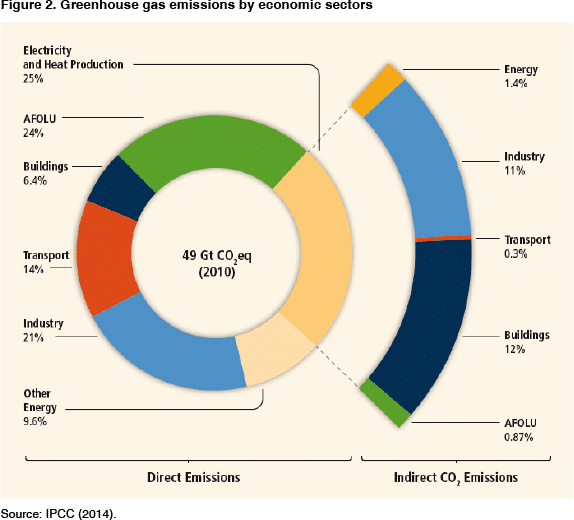
Having analysed the key developments in science, economics and energy we now turn to the analysis of changes in global climate governance in the run-up to the Paris Climate Conference.
Climate change governance ahead of COP21: from the French Presidency to the Pope
The French Presidency of COP21 worked throughout 2015 to prepare the climate conference in Paris. The COP President, Laurent Fabius, as well as his team, were praised throughout the meeting for their ability to listen, ensure transparency10 and broker consensus on the main sticking points. One of the innovative moves by the French was their invitation of Heads of State and Government to intervene at the beginning rather than at the end of the COP, as was the case in Copenhagen. This showcased political will and arguably helped push technical work forward from the outset.
In stark contrast to COP15, expectations as regards the outcome of the Paris Conference were lower than expectations regarding the outcome of the Copenhagen Conference. French diplomacy, think tanks and academics alike11 had warned the world that COP21 results would not solve the climate-change problem. Paris was not thought of as the COP to end all COPs, as was perhaps Copenhagen for some outside observers. The fact that an agreement to succeed the Kyoto Protocol12 was not reached during COP15 and the realisation that solving the climate problem means totally transforming productive systems and consumption patterns were powerful reasons to purposefully lower expectations as regards the Paris outcome.
Following a bottom-up approach to raising ambition, all countries, developed and developing, were asked in December 201313 to submit their Intended Nationally Determined Contributions (INDCs)14 well in advance of COP21, according to their common but differentiated responsibilities and respective capabilities (CBDR-RC) in the light of national circumstances. This is a substantial change from the Kyoto Protocol that was based on developed countries (that had historically contributed more to GHG emissions) being the only ones with emission reduction targets. There has thus been a transition from blame to collective will to act according to national possibilities and priorities. The result of this was that by 1 October 2015 some 119 INDCs from 147 parties, representing 86% of global emissions in 2010, had been submitted, a first in the history of climate negotiations.15 These figures are indeed impressive as they include almost all parties and all major GHG emitters.
Keyemitters were on board. China and the US had jointly announced in November 2014 their intention to work together to ensure the adoption of an agreement in Paris. In its INDC, the US announced it would reduce its emission by 26%- 28% below its 2005 level by 2025, emphasising that the target is in line with an 80% reduction of GHG emissions by 2050.16 Figure 3 below shows historic and projected US GHG emissions in 2020 and 2025.17
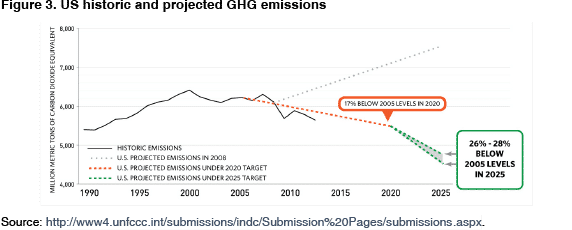
China’s INDC claimed its intention was to both reach its emissions peak and increase the share of non-fossil fuel energy sources in its energy mix to 20% by 2030. In addition, China’s CO2 intensity per unit of GDP is to be reduced by 60%-65% compared with 2005 levels. China also committed to increase forest cover by 4.5 billion cubic metres compared with 2005 levels.18
Europe’s contribution was announced ahead of those of the US and China at the European Council in October 2014. The European INDC included an economy-wide GHG reduction target of no less than 40% by 2030 compared to 1990. This target is to be jointly fulfilled, with no use of international market-based mechanisms. Allocation of the target among member countries is yet to be finalised.
However, the commitments described above, contained in the US, Chinese and European INDCs, are rated ‘medium’ according to Climate Action Tracker.19 This means that if all governments’ efforts were in this range, global average warming would likely exceed 2°C. This is also the case of other major emitters such as Brazil and India. INDCs submitted by Japan, Russia and South Africa, among others, are rated insufficient, meaning that if all governments put forth similar efforts to these countries, global average warming would likely be in the range of 3°C to 4°C. Only Bhutan, Costa Rica, Ethiopia, Gambia and Morocco (the latter to hold the future COP22 Presidency) have submitted intended contributions in line with the goal of limiting mean global temperature increases to 2°C.
Therefore, neither INDCs submitted before or during COP21 are enough to provide the world with a reasonable likelihood of limiting average global temperatures to 2°C above pre-industrial levels. In fact, the median increase in global average temperatures is likely to be 2.7°C in 2100 compared to pre-industrial levels, provided all pledges included in the INDCs are fully implemented.20 This reality check reinforces the need for continued negotiations and increased ambition over time.
In addition to national commitments, unprecedented action at subnational, city and firm level is occurring. The traditional top-down approach to climate regime building is being progressively transformed. Initiatives from business, cities, regions and civil society have been channelled, inter alia, through the Lima-Paris Action Agenda (LPAA). The LPAA crystallised in over 10,000 concrete actions, engagement by over 2,000 cities, more than 2,000 companies21 as well as more than 200 civil society organisations. Figure 4 2 below summarises some of the key announcements by the LPAA.
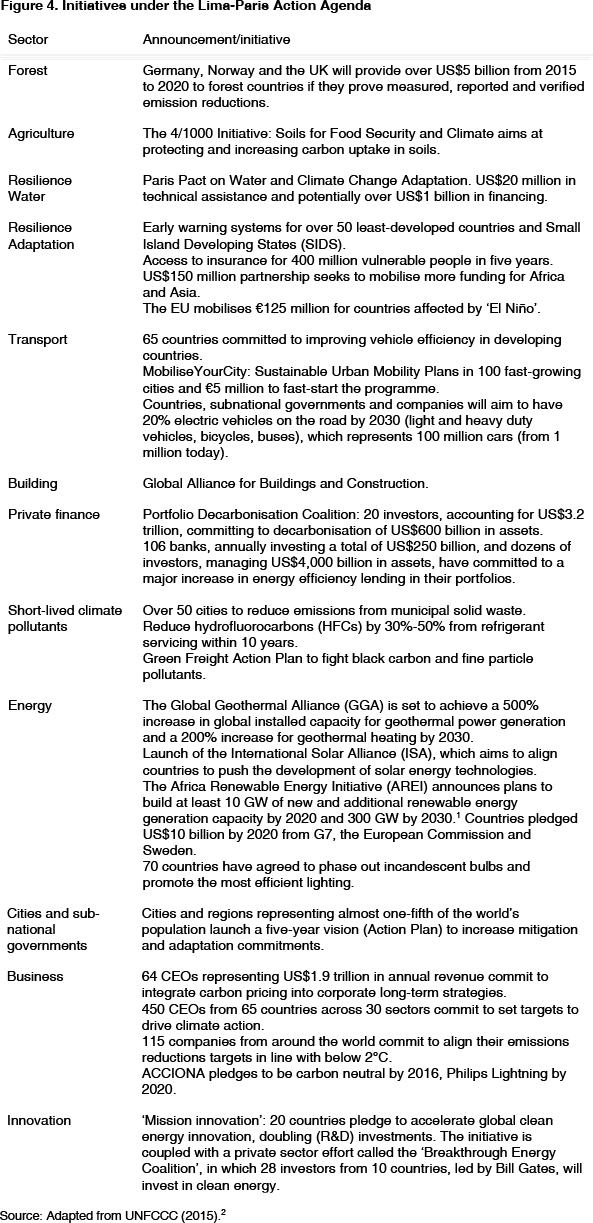
Finally, in 2009 the Interfaith Declaration on Climate Change24 was presented during COP15 to Yvo de Boer.25 In the document many of the world’s faiths called for decisive action to fight climate change and stated ‘climate change is not merely an economic or technical problem, but rather at its core is a moral, spiritual and cultural one’.26 Six years later, the publishing of Pope Francis’ Encyclical Letter Laudato Si27 on the care of our common home has made headline news and has contributed to the outcome in Paris. In that Letter Pope Francis calls for ‘substituting fossil fuels and developing sources of renewable energy’ (Bergoglio, 2015, p. 21).28
Given the analysis above, we now turn to the key outcomes of COP21.
The Paris Agreement: main elements and preliminary assessment
After over 20 years of climate negotiations the Paris Agreement adopted in 2015 could be remembered for providing humanity with the framework for decisive climate action, if current INDCs are fully implemented and ambition is regularly ramped-up. In order for increased ambition to materialise an orderly and asymmetric transition to a low carbon economy is needed. A monumental task considering that this transmutation would have to occur in almost 200 countries at various stages of development and facing a wide variety of socio-economic and political situations. The joy of diplomatic success must not lead to complacency. We have to act now and continue to do so until low carbon economies become the norm. Success will be measured against the 2°C (1.5°C) benchmark and that will require nothing short of a post-industrial green revolution. The key elements in the Paris Agreement are summarised in Figure 5 below.

Figure 5 above contains positive elements that frame the future climate regime. The references to 2°C (and 1.5°C) plus the goal of net zero emissions by the second half of the century provide us with a collective way forward. Additionally, five-year reviews, a common framework for transparency and a ratcheting-up mechanism will –it is to be hoped– prevent backsliding. Naming and shaming instead of sanctions is also supposed to avoid declining ambitions.30 In terms of finance, the US$100 billion benchmark and the goal of increasing finance are included.
Despite the positive elements detailed above, the agreement opted for universal participation and hence, understandably, fell short of the required ambition level. During the negotiation process various issues of paramount importance were left out of the agreement. These include: a CO2 price, sectoral references regarding energy, the built environment and the role of cities. The transport sector and bunkers (aviation and shipping), whose emissions could represent 40% by the middle of the century31, have also been left out. There are furthermore other issues that have not been adequately specified in the Paris Agreement, such as the sources of climate finance, accounting guidelines and how climate finance would be allocated and managed.
Conclusions
The Paris Agreement has salvaged, for the time being, the multilateral climate process. Central to the Paris Agreement, the common narrative to pursue energy efficiency, energy security, development goals and more broadly sustainable development may have pushed climate commitments somewhat beyond the lowest common denominator. There is currently a broad approach to INDCs, which include commitments beyond GHG emission reductions, such as adaptation. There has also been a gradual blurring of the divide between developed and developing countries,32 by way of including all countries in the INDC scheme. Broadening of the INDC scope plus blurring of past country divisions may have facilitated, inter alia, the Paris Agreement.
A successful climate agreement in which there is broad participation, honouring of pledges and significant behavioural change by big emitters is what we should aspire to. Some elements of this winning formula are in the Paris Agreement. Almost 200 countries adopted the Paris Agreement and current INDCs account for over 98% of world emissions. Paris brings a dynamic agreement that seeks to limit temperatures to well below 2°C, demands net-zero emissions this century, ensures a transparency mechanism applicable to all and requires increased ambition, while accounting for differentiation and being supported by climate finance.
Missing elements such as a CO2 price or references to bunkers, greater specification as regards finance and implementation of the agreement will determine whether a historical agreement has indeed been reached. Current commitments, if fully implemented, will imply overshooting the 2°C goal by about one degree. This fact alone should motivate prompt, decisive and continued climate action by all stakeholders. The stakes could not be higher.
Lara Lázaro-Touza
Senior Research Fellow at the Elcano Royal Institute and Lecturer in Economic Theory at Cardenal Cisneros University College in Madrid | @lazarotouza
1 IPCC (2014), ‘Climate Change 2014 synthesis report. Summary for policymakers chapter’.
2 Scientific consensus: Earth’s climate is warming.
3 P. Howard & D. Sylvan (2015), ‘Expert consensus on the economics of Climate Change’, Institute for Policy Integrity, New York University School of Law; and N. Stern (2013), ‘The structure of economic modelling of the potential impacts of Climate Change: grafting gross underestimation of risk onto already narrow science models, Journal of Economic Literature, vol. 51, nr. 3, p. 838-859, http://dx.doi.org/10.1257/jel.51.3.838.
4 M. Dell, B.F. Jones & A. Olken (2012), ‘Temperature shocks and economic growth: evidence from the last half century’, American Economic Journal: Macroeconomics, vol. 4, nr 3, p. 66–95, http://dx.doi.org/10.1257/mac.4.3.66.
5 M. Burke, S.M. Hsiang & E. Miguel (2015), ‘Global non-linear effect of temperature on economic production’, Nature, nr 527, p. 235-239, DOI:10.1038/nature15725.
6 World Economic Forum (2015), ‘Global risks 2015’, 10th edition.
7 BlackRock Investment Institute (2015), ‘The price of Climate Change. Global warming impacts on portfolios’, October.
8 IRENA (2014), Rethinking energy. Towards a new power system.
9 University of Cambridge and PwC (2015), ‘Financing the future of energy. The opportunity for the Gulf’s financial services sector. A report for the National Bank of Abu Dhabi’, March.
10 COP21: Damian Ryan asks if Paris is keeping on track.
11 From Copenhagen to Paris: Low Expectations.
12 D. Bodansky (2010), ‘The Copenhagen Climate Conference: a post-mortem’, The American Journal of International Law, vol. 104, nr 2, April, p. 230-240.
13 United Nations Framework Convention on Climate Change, Report of the Conference of the Parties on its nineteenth session, held in Warsaw from 11 to 23 November 2013. Addendum, Part two: Action taken by the Conference of the Parties at its nineteenth session.
14 Intended Nationally Determined Contributions (INDCs) are countries’ post 2020 climate commitments.
15 The submission of INDCs continued throughout the COP. At the time of writing, 160 INDCs have been submitted, representing 188 parties and 98.6% of global emissions. See http://cait.wri.org/indc/.
16 U.S. Cover Note INDC and Accompanying Information.
17 President Obama also announced in August 2015 the Clean Power Plan aimed at reducing GHG emissions from the power sector by 32% below 2005 levels by 2030. Renewable energy will be ramped up and new fuel efficiency standards for heavy-duty vehicles will be implemented by 2019.
18 China’s INDC – on 30 June 2015. Additionally, the joint statement by China and the US in September 2015 confirmed China’s intention of launching a nation-wide emissions trading scheme by 2017 that would cover the power sector as well as the main industrial sectors. A ‘green dispatch’ will also be implemented to promote low-carbon energy sources in the electricity mix.
19 Climate Action Tracker, Tracking INDCs.
20 The full range of increases in temperature is 2.2°C-3.4°C. Climate Action Tracker (2015), ‘Paris Agreement: near-term actions do not match long-term purpose – but stage is set to ramp up climate action’.
21 The market value of companies that have made commitments under the Lima Paris Action Agenda is equivalent to the GDP of China, France and Germany combined. See Lima-Paris Action Agenda Matures into Major Force Driving Climate Action.
22 Africa Renewable Energy Initiative, Transforming Africa towards a renewable energy powered future with access for all.
23 Lima-Paris Action Agenda Matures into Major Force Driving Climate Action.
24 S. García Acuña (2010), ‘La Conferencia de Copenhague sobre el Clima y la Declaración Interreligiosa sobre el Cambio Climático: un acercamiento a la aportación de las religiones a la crisis atmosférica’, Documento de Trabajo, nr 18/2010, Real Instituto Elcano.
25 Yvo de Boer was the Executive Secretary of the UNFCCC from 2006 to 2010.
26 Interfaith Declaration on Climate Change.
27 Laudato Si’.
28 Jorge Mario Bergoglio (Pope Francis) (2015), Encíclica Laudato Si, Romana Editorial.
29 NewClimate Institute, What the Paris Agreement means for global climate change mitigation.
30 This has been a hotly debated issue although the Kyoto Protocol experience could support the shift away from sanctions.
31 European Parliament (2015), ‘Emission reduction Targets for International Aviation and Shipping. Study for the ENVI Committee’.
32 L. Hermwille, W. Obergassel, H.E. Ott & C. Beuermann (2015), ‘UNFCCC before and after Paris – what’s necessary for an effective climate regime?’, Climate Policy, DOI: 10.1080/14693062.2015.1115231.
